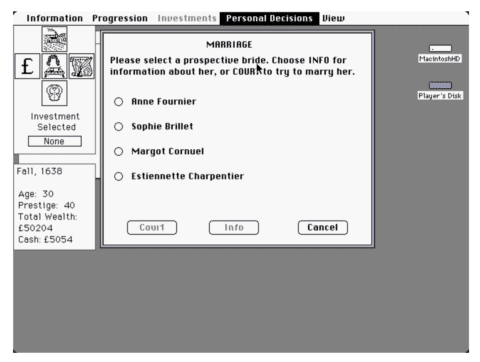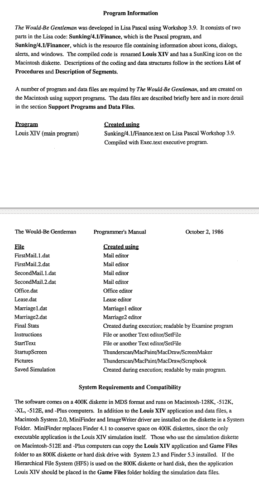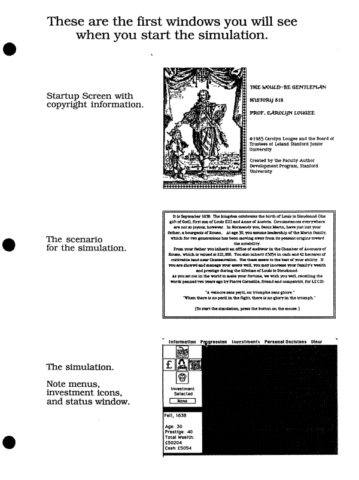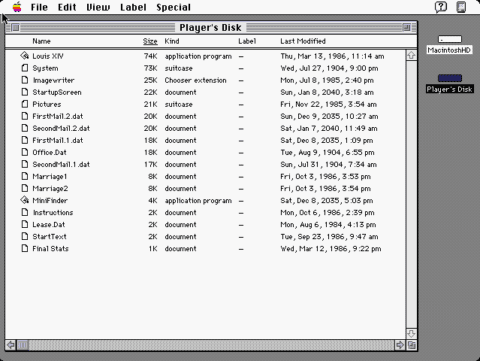NOTE: EaaSI Case Studies are formatted based on the FCoP Teaching Case Study template developed by Dr. Amelia Acker and published by the Software Preservation Network in June 2020 as part of the IMLS-funded Fostering Communities of Practice project.
Name of Case Study
“The Would-Be Gentleman”
Unit + Institution’s name
This project was led by the Born-Digital Preservation Lab at Stanford Libraries.
Unit members
There are currently two staff members who work in the Born-Digital Preservation Lab (BDPL). One is the Digital Archivist, responsible for imaging legacy media and processing born-digital content; the other is the Service Manager, who manages the development of policies and workflows for born-digital preservation and access. The Service Manager is also the project lead for EaaSI at Stanford, and facilitates testing for a larger team of stakeholders from across the library.
The Problem
“The Would-Be Gentleman” is a floppy disk simulation created by Stanford history professor Carolyn Lougee in 1985. It was originally created as supplementary course material for Professor Lougee’s History seminar, “The France of Louis XIV”, though it was also made broadly available in the Academic Courseware Exchange, a catalog of educational software distributed by Kinko’s Copies. Players must manage the economic and social life of a French bourgeois during the life and reign of Louis XIV of France, 1638–1715, by making decisions about income, properties, marriage, and alliances. The game is intended for undergraduates studying the economic life of the period.
“The Would-Be Gentleman” was selected for emulation by Stanford’s University Archivist, as a representative example from a University Archives collection of early interactive academic software authored by Stanford faculty. Its status as part of an archival collection, rather than a commercial acquisition, makes it an appealing test case for description and access in the context of archives and special collections. The collection itself contains a wide range of course materials developed by Stanford professors and staff from 1984–1995, meaning a successful emulation may lead to providing access to the rest of the collection.
The content of the object is also particularly well-suited to emulation. Lougee developed the simulation in an attempt to address a difficulty she identified in teaching social history. As she wrote at the time and reiterated during the emulation process:
“The large-scale and long-term processes that social historians now consider the heart of the past are often difficult for undergraduate students to comprehend. Fluctuations and trends in demographic indices, market prices, interest rates, weather, and popular uprisings are too abstract to engage students easily and often seem so remote from individuals’ and groups’ experiences that students have little interest in understanding how they work. The same could be said of other unfamiliar features of the past such as patronage networks, court societies, and definitions of prestige or status in a hierarchical social structure.”
In this light, a successful emulation would not just restore interactivity in the “The Would-Be Gentleman” as a software object, but as a teaching theory.

The Audience
We expected that successfully emulating this game would be of interest to three audiences. The impetus for the emulation experiment was the creator herself, Carolyn Lougee, who is a professor emerita still involved in the Stanford community and interested in re-visiting her work. As the work is situated within the University Archives collections, special collections and archival researchers could also encounter “The Would-Be Gentleman” while searching for French history, computer games, or Stanford’s history of academic software. And, as emulation is still in a testing phase at Stanford, this game would provide the wider University Archives and Stanford Libraries staff, including UX and access teams, with a model for how to work with and present Stanford-specific born-digital projects.
The Tool Chain
The software required for the simulation included both the game itself and the operating system on which it ran. The Stanford BDPL had previously created disk images of each of the five 3.5-inch floppy disks associated with the game. Each of those disks held different content: “Pictures,” “Player’s Disk,” “Source Code: Simulation,” “Source, Data, Editors, and Manuals,” and “Support Programs and Data Files.” It was not initially clear which one of these held the simulation program, or whether we’d need content from multiple disks for successful emulation. Documentation stored with the game, written in October 1986, indicated that the game would run on Macintosh-128K, -512K, -XL, -512E, and -Plus computers. At the time the manual was written, these computers could run System (MacOS) 1.0 through 3.2.
The hardware required for the simulation was from the early days of the Macintosh line. Documentation stored with the game, written in October 1986, indicated that the game would run on Macintosh-128K, -512K, -XL, -512E, and -Plus computers. These early Macintoshes, or Apple’s first personal computers successful with consumers, ran on Motorola 68k microprocessors.
The Digital Archivist at Stanford and the Software Preservation Analyst at EaaSI worked together to come up with a successful emulation environment.

The Process
Using the documentation accompanying the disk images, Stanford’s Digital Archivist worked with the EaaSI Software Preservation Analyst to identify the necessary pieces for testing.
The environment eventually used for emulation relies on the BasiliskII emulator, configured to run Mac IIci (hardware) and MacOS 7.01 (software). This environment was already created at Yale University Library’s EaaSI node, but had not yet been published for other EaaSI nodes to reuse. The Software Preservation Analyst made the environment public, allowing the Stanford team to copy and use it to test “The Would-Be Gentleman.”
The BasiliskII emulator supports Macintosh II hardware (1987-1993), while the game documentation only mentions earlier Macintosh computers, which run a different version of the Motorola 68k CPU. In addition, the Basilisk emulator can only run MacOS versions beginning at 7.x, but at the time “The Would-Be Gentleman” was created and documented, Apple had only released versions of System through 3.2. However, the Macintoshes listed in the documentation did run versions of System (MacOS) through 7.5.5, so testing with MacOS 7.01 seemed appropriate.
Preliminary testing was successful relying on this combination of hardware and early software. The provided user manual for the game is quite detailed, possibly because the game dates from early in the personal computer era, plus the fact that “The Would-Be Gentleman” was intended for educational settings and aimed at history students in particular, who may not have been familiar with using personal computers or the Macintosh specifically. The Digital Archivist was able to test the emulation by following instructions in the manual and comparing with the running program until reasonably confident the game was working as intended (and then continued until she was reasonably confident that she was on her way to becoming a French gentleman).

If this environment proves inadequate for full gameplay, the Mini vMac emulator covers the exact range of hardware and software specified by the game documentation (unlike BasiliskII). However, there is not currently a version of the Mini vMac emulator compatible with the EaaSI platform, so a request has been made for the Yale and OpenSLX teams to support Mini vMac in a future EaaSI update.
Overall, the process to create a working emulation took two days. The results are good news, and promising for the rest of the collection, as University Archivist Josh Schneider says:
“The Faculty Author Development Project collection contains a treasure trove of early software applications created at Stanford between 1984-1986 through collaborations between faculty and Instruction and Research Information Systems, a division of Academic Computing that provided microcomputing equipment and programming support. Many of the faculty who participated were affiliated with the Humanities and Social Sciences. It’s wonderful to see these applications given new life via software emulation. The successful emulation of ‘The Would-be Gentleman’ bodes well for other titles in the collection that are promising for research, from the medical and philosophy tutorials, to the Elizabethan stage performance and modern cinema mogul simulators.”
Overcoming roadblocks
The main struggle with “The Would-Be Gentleman” was uncertainty around the necessary environment to start testing. It was unclear which emulator to use, and incorrect information from the emulation projects themselves did not help (the BasiliskII homepage incorrectly lists that it is capable of emulating a Macintosh Classic and MacOS versions older than 7.x). BasiliskII ended up being alright for this use case but the backwards compatibility of early Mac systems created a gray area – it is difficult without a lot of time and testing to know when or on what MacOS version a Macintosh application like “The Would-Be Gentleman” would break.
The current lack of a persistent environment URL in EaaSI also highlights the challenge of access. “The Would-Be Gentleman” is discoverable in Stanford’s Digital Repository, but how would researchers know an emulation is available? How would the EaaSI environment appear in the item repository record? Who should researchers contact in order to view an emulation, and how? Providing a login to the EaaSI platform to see “The Would-Be Gentleman” in emulation at least provides the opportunity for BDPL staff to open the conversation with other Library teams to solve these questions with an example. [Note from the EaaSI team: persistent access links are part of the development roadmap for the first half of 2021; integration with existing systems and workflows, however, will remain a pressing and consistent concern!]
Where the emulation lives
There is not yet functionality within EaaSI to link directly to an emulation environment, so to test it out, users will have to go to sul-eaasi-pilot.stanford.edu/ and log in with demo credentials.
Once in, users must navigate a series of steps through the EaaSI menu to Environments (left menu) -> Object Environments (tab) -> scroll through to “The_Would-Be_Gentleman” -> click “Choose action” (drop-down menu on right) -> “Run Environment.” This should launch the emulation environment.
Once it is launched, click within the emulation window to control the mouse. (A dialog box about a driver for AppleTalk will pop up; you can click OK and ignore.) Double-click on the desktop folder labeled “Player’s Disk.” Go to Menu -> View by size; a file called “Louis XIV” should be on top, and users can double-click it to launch the game.
